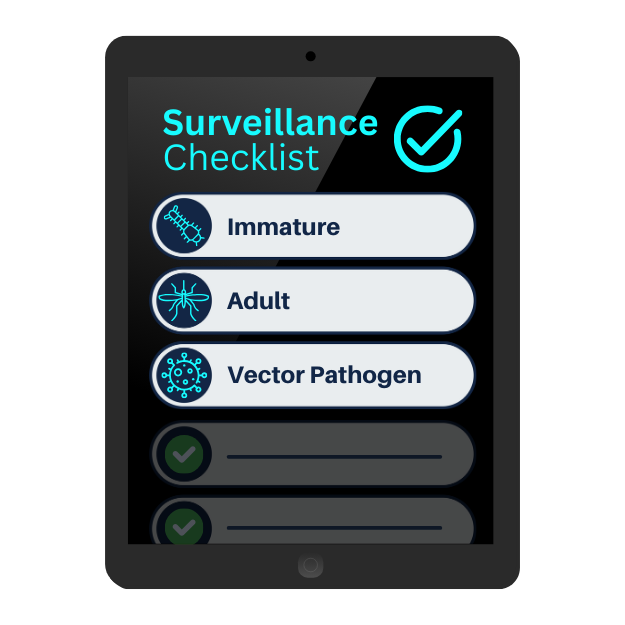Integrated Pest Management Overview: Part 2
Surveillance
 A one-time field collection of mosquitoes is considered a survey and will provide a snap-shot assessment of mosquito activity at a particular time and place.
However, the natural world is dynamic and requires continuous evaluation. Seasonal changes significantly impact mosquito populations through shifting mosquito
development habitats along with the host species that mosquitoes prefer to feed upon. As mosquito feeding behavior changes, the disease pathogens they transmit
can likewise shift to alternate hosts such as people and our pets. Compiling and assessing data from consecutive surveys through the seasons and over the years
is how mosquito surveillance is best used to guide and optimize subsequent mosquito control operations.
A one-time field collection of mosquitoes is considered a survey and will provide a snap-shot assessment of mosquito activity at a particular time and place.
However, the natural world is dynamic and requires continuous evaluation. Seasonal changes significantly impact mosquito populations through shifting mosquito
development habitats along with the host species that mosquitoes prefer to feed upon. As mosquito feeding behavior changes, the disease pathogens they transmit
can likewise shift to alternate hosts such as people and our pets. Compiling and assessing data from consecutive surveys through the seasons and over the years
is how mosquito surveillance is best used to guide and optimize subsequent mosquito control operations.
A mosquito surveillance program is scientifically designed to evaluate species abundance, composition, and distribution in the areas of concern. Public Health vector surveillance requires monitoring immature and adult mosquito populations as well as keeping tabs on the disease pathogens circulating within blood fed hosts and the mosquitoes that transmit those pathogens.
Immature Mosquito Surveillance
- Egg production can be monitored with oviposition cups strategically placed to target container Aedes species such as Aedes aegypti and Aedes albopictus. Within urban environments, the egg rafts of Culex species such as Culex quinquefasciatus can often be collected in larger containers with water high in organic matter.
- Larval and pupal surveillance is principally conducted by dip sampling from water bodies that support mosquito larvae development. Locating larval development sites is a fundamental skill necessary for identifying potential troublesome areas of impending mosquito activity and determining the appropriate control actions for these sites.
- Standardized dipping protocols are necessary to develop usable data for continuous surveillance monitoring.
Removing water sources is the most effective form of mosquito control. When this is not possible, identifying those mosquito development sites for larval treatments is the next best action.
Adult Mosquito Surveillance
- Adult mosquito surveillance attempts to locate areas of greatest mosquito activity.
- The trapping methods used to evaluate adult mosquito activity include baited and unbaited light traps, gravid/oviposition traps, resting traps, and emergence traps.
- The various trap types are designed to attract adult mosquitoes in different physiological states, such as host-seeking or gravid.
- All trap types have a bias for certain mosquito species, and this must be considered in evaluating trapping data.
- The use of multiple trap types in an area can give a better picture of overall mosquito activity and potential for disease conditions that can initiate a treatment response.
Vector Pathogen Surveillance
Prevention of vector-borne disease transmission is the primary goal of a Public Health Vector Control program. Surveillance of the pathogens that cause disease relies on timely field collections to provide insight as to when and where to initiate treatment interventions. Nuisance mosquito reduction is also a fundamental goal as a reduction in overall mosquito population levels can lower the likelihood of pathogen transmission while also improving quality of life. Arbovirus surveillance methods can vary based on available resources and is a continuous process.
- Field-collected sampling can be obtained from mosquitoes, domestic animals such as chickens, wild caught birds, or other animals.
- Sample testing can vary by method and looks for specific indicators such as the pathogen itself through isolation of genetic materials, or signs of the pathogen by host response such as the presence of antibodies.
- Positive results may initiate a mosquito control treatment based on historical data and relative risk associated with pathogen and local abundance.
- Communication with the local and state Health Department is part of a comprehensive integrated mosquito management plan.
Surveillance is vital to any integrated mosquito management program. The information gained from field sampling allows for proactive decision making to optimize mosquito control activities when targeting problematic mosquito populations. With limited resources and the health of the public at stake, mosquito control agencies rely on their surveillance programs to best serve their citizens.
In Part 3 of our IPM series, we will review the larval treatment methods and products that mosquito control programs rely on to keep troublesome adult mosquitoes from developing.







